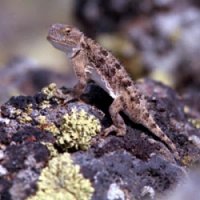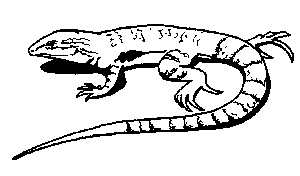Resource Cards
![]()

Three kinds of lizards make their home in the lower Columbia Basin.
![]()
Lizards are the most abundant form of reptile life found in the world today. All lizards are ectothermic, or cold-blooded, which means their inside body temperature is the same as the temperature of the air outside of their bodies. So, when the air temperature is cool, lizards sit in the sun to get warm, and when it is hot, they sit in the shade to get cool.
Even though you may have never seen one, three kinds of lizards are found in shrub-steppe lands of the lower Columbia Basin: the side-blotched lizard, northern sagebrush lizard, and short-horned lizard. The side-blotched lizard is the most abundant lizard in the area.
What do the Columbia Basin lizards look like?
All three lizards found in the Columbia Basin are really small-ranging from only about 1-1/2 to 4 inches long, maybe no bigger than your thumb or forefinger.
The side-blotched lizard, generally the smallest of the three local species, is named for the large black spot found on the sides of its body behind the front legs. It is brownish gray.
The sagebrush lizard has a long blue patch on each side of its belly and is sometimes referred to as the blue-bellied lizard, though the rest of its body is gray or brown.
Short-horned lizards have wide, flat bodies with short legs and tails. They also have sharp spines on their heads, backs, legs, sides, and tails that help protect them from predators. They are perfectly colored to blend in with the buff-colored shrub-steppe.

How do Columbia Basin lizards live?
The side-blotched lizard eats insects such as spiders, mites, and scorpions and likes the gravelly soil of the flat shrub-steppe with lots of rocky places and bushes under which it can hide. You can find side-blotched lizards at lower elevations around the Tri-Cities in habitats ranging from sand dunes and sagebrush flats to areas dominated by sagebrush and bunchgrass. The sagebrush lizard is a fast, expert climber and often clings to overhanging rocks. Like the side-blotched lizard, it eats insects and hides under rocks or bushes when it is startled. Sometimes, the sagebrush lizard seems to call attention to itself by raising and lowering its head and body, revealing its blue belly. It is found only at low elevations and in sandy areas.
Ants are the favorite food of the short-horned lizards. They use two special "tricks" to escape their predators. One is to make themselves look much larger than they really are by inflating their bodies with air-which makes their sharp spines look bigger, too. The second trick is to squirt blood out from their eyes, which surprises the enemy so that the short-horned lizard can run away.
![]() "Science is constructed of facts as a house is of stones. But a collection of facts is no more a science than a heap of stones is a house." Henri Poincare
"Science is constructed of facts as a house is of stones. But a collection of facts is no more a science than a heap of stones is a house." Henri Poincare
Keep in mind this fact sheet is intended to be used only as background information to support your effort to encourage inquiry-based science, which parallels the way scientists uncover knowledge and solve problems.
![]()

Using references from the classroom, library, and World Wide Web, students can:
- create Venn diagrams to explain how lizards differ from snakes and other reptiles.
- create resource cards or posters, complete with pictures and facts, of their favorite reptiles.
- create a timeline showing how lizards evolved from amphibians.
- research which lizards live in Washington State, locate their habitat on the map, and provide a picture and brief facts about each one.
- investigate why lizards have decreased in the Columbia Basin since the time of Lewis and Clark.
- create a class newspaper entitled "The Leaping Lizard," writing ads and news stories based on lizard "facts."
- create paper-mache or clay models of lizards the class has studied.
- create lizard limericks to post over models or pictures of lizards.
- create a lizard web site where the class posts information they have gained on lizards to share with others.
- create a cluster demonstrating the importance of the "lizard" in the web of life.
- create and illustrate Lizard Legends-fables based on lizard facts.
To increase students' observational skills, provide opportunities for them to study lizards in their natural surroundings.
Questions a scientist might ask: Where did you see the lizard? (in the open, under a bush) What time of the day was it? (morning, noon, or evening) What was the lizard doing? (sleeping, running, sitting on a rock or under a sagebrush, eating, drinking) Describe the lizard: How long was it? What was its color? What kinds of plants did you see in the area? What kinds of insects or other animals did you see there?
Invite a wildlife biologist into the classroom to talk about local lizards.
![]()
- Amazing Lizards, 1990. Trevor Smith, Eyewitness Series, Knopf, New York.
- Amphibians of Washington and Oregon, 1993. P. Larrisen, R. Storm, H. Brown, Seattle Audubon Society, Seattle, Washington.
- Lizards as Pets, 1971. Richard Headstrom, Lippencott Company, New York.
- Peterson First Guides: Reptiles & Amphibians, 1992. R. Conant, J. Collins, R. Stebbins, Houghton Mifflin, Boston.
- Ripley's Believe It or Not: Reptiles, Lizards, & Prehistoric Beasts, 1993. H. Zimmerman, E. Henderson, TOR Books, New York.
- Shrub-Steppe Seasons A Natural History of the Mid-Columbia Basin, 1997. Lee E. Rogers, Pacific Northwest National Laboratory, Richland, Washington.
- Swifts and Spiny Lizards , 1998. Ray Hunziker, TFH Publications, Newton, New Jersey.
- Lizards, Frogs, and Polliwogs: Poems and Paintings , 2001. Douglas Florian, Harcourt Brace, New York.
- The World of Lizards, 1982. G. Earl Chance, Dodd, Mead, & Company, New York.
![]()
- An Animal of the High Desert—Sagebrush Lizard http://www.stoller-eser.com/sagebrushlizard.htm
- Desert Animals and Wildlife http://www.desertusa.com/animal.html
- Horned Lizards http://www.lifesci.utexas.edu/faculty/pianka/phryno.html
- The Lizard Lounge http://www.the-lizard-lounge.com
- Natural History of Lizards http://www.humboldt.net/~tracker/lizard.html
- Sagebrush Lizard http://imnh.isu.edu/digitalatlas/bio/reptile/lacer/scgr/scgr.htm
- Side-blotched Lizard http://www.wildherps.com/species/U.stansburiana.html
- Side-blotched Lizard http://www.desertusa.com/mag99/nov/papr/lizar.html
![]()
Initial development and printing was funded by the Partnership for Arid Land Stewardship (PALS). Project Manager: Karen Wieda. Written by: Michelle Woodward, Aspen Academy. Series Editor: Georganne O'Connor; Design: WinSome Design.
![]()
